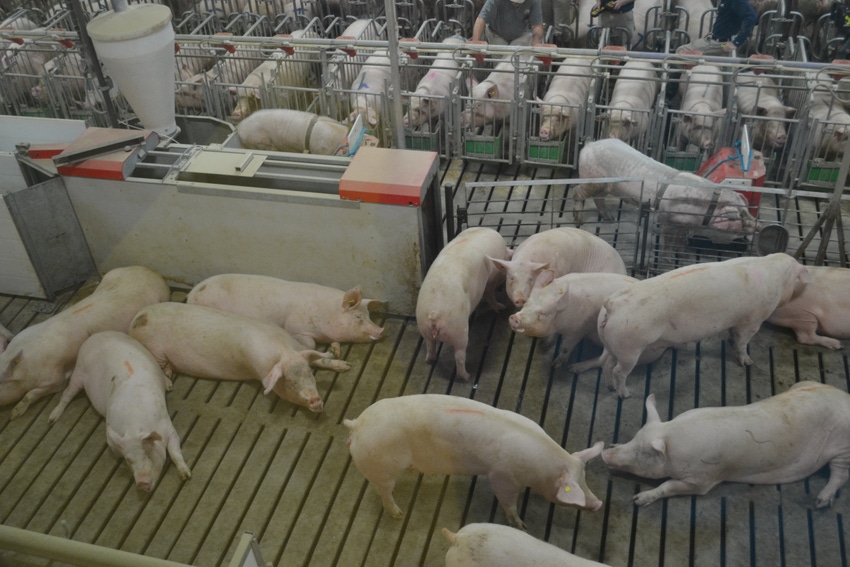How to convert weekly farrowing groups to single batch breeding group
Are you returning to batch farrowing? Consider this strategy for regrouping sows.

Recently, there has been a renewed interest in batch farrowing schedules in North America. There are many reasons why this is being considered and each operation contemplating a shift to a batch system probably has different ideas with regards to how it might benefit their situation. However, one challenge that all will face is how to create batch breeding groups from a weekly farrowing schedule. Figure 1 outlines one strategy that has proven successful for taking four consecutive weekly farrowing groups and converting them to a single batch breeding group 4 weeks later. It relies on the use of orally active synthetic progestogens that are available for synchronization of estrus in mature gilts and the normal estrous activity that occurs in sows after weaning.
Figure 1. Regrouping of 4 weekly farrowing groups into a one breeding group in 4 weeks using orally active progestogens and normal estrous activity of sows after weaning.

The first group of sows farrowing on a weekly schedule are weaned; given boar exposure; but when found in estrus they are not bred – similar to what is done in a “heat-no service” strategy. When these sows are not bred, they should revert back to having normal estrous cycles of 18 to 22 days. Consequently, sows in this group should exhibit estrus again in 3 weeks which would be four weeks after they were weaned assuming they had a normal weaning-to-estrus interval of 7 days or less.
The second group of sows on the weekly schedule needs to be fed one of the orally active progestogen products that have been approved for synchronization of estrus in mature gilts for 16 days beginning two days before weaning. The suckling action of piglets inhibits the release of gonadotropins during lactation via a neural reflex arc. Progestagens accomplish the same thing but do so by direct actions on portions of the brain that control gonadotropin secretion. This is why sows typically do not show estrus when they are pregnant since progesterone is high during gestation. Previous research has shown that sows typically exhibit estrus between 4 and seven days after orally active progestogens have been removed from their feed. This strategy delays the post-weaning estrus in this group of sows for about two weeks so that it occurs about three weeks after they were weaning and during the same week as the group of sows weaned the previous week.
The third group of sows on the weekly schedule is managed the same way as the second group except they are fed progestogens for only nine days, again, beginning two days before they are weaned. This is due to the need for their post-weaning estrus to be delayed for only one week instead of two. Group 3 will show estrus two weeks after they were weaned. Finally, the fourth group of sows is weaned and bred on schedule during the subsequent week just as if they were still on their normal weekly schedule. The end result is that four groups of sows on a weekly system are “batched” into a single group and bred during the same week. This is done by allowing two of the groups (1 and 4) to exhibit normal estrous activity after weaning while the timing of estrus in the other two groups (2 and 3) is controlled with orally active progestogens.
Both the synchronization or “regrouping” efficiency and reproductive performance from using this approach has proven to be very good on commercial farms. Table 1 contains numbers of sows bred and their subsequent farrowing rates and litter sizes for each of the four weekly groups “batched” into a single group. It should not be surprising that there is a tendency for sows in the first three groups to have slightly improved reproductive performance compared with their contemporaries in group 4 since they were given an extended period to recover following lactation in order to regroup them into the same batch. It is important to remember that the success of this strategy ultimately depends upon how well sows are managed during lactation. Farms with a high percentage of sows that return to estrus within seven days post-weaning are likely to have very good results compared with those that experience prolonged weaning-to-estrus intervals.
Table 1: Regrouping efficiency and subsequent reproductive performance after conversion from a weekly to a 4-week batch farrowing schedule1

1 Data from 16 weekly farrowing groups reorganized into 4, 4-week batches
2 Numbers in parentheses are percentage of sows bred in batch of those weaned from each weekly group
3 Feeding of oral progestagens began 2 days before weaning and then fed for 14 days
4 Feeding of oral progestogens began 2 days before weaning and then fed for 7 days
5 Regrouping efficiency and reproductive performance of the 4-week batch
About the Author(s)
You May Also Like





